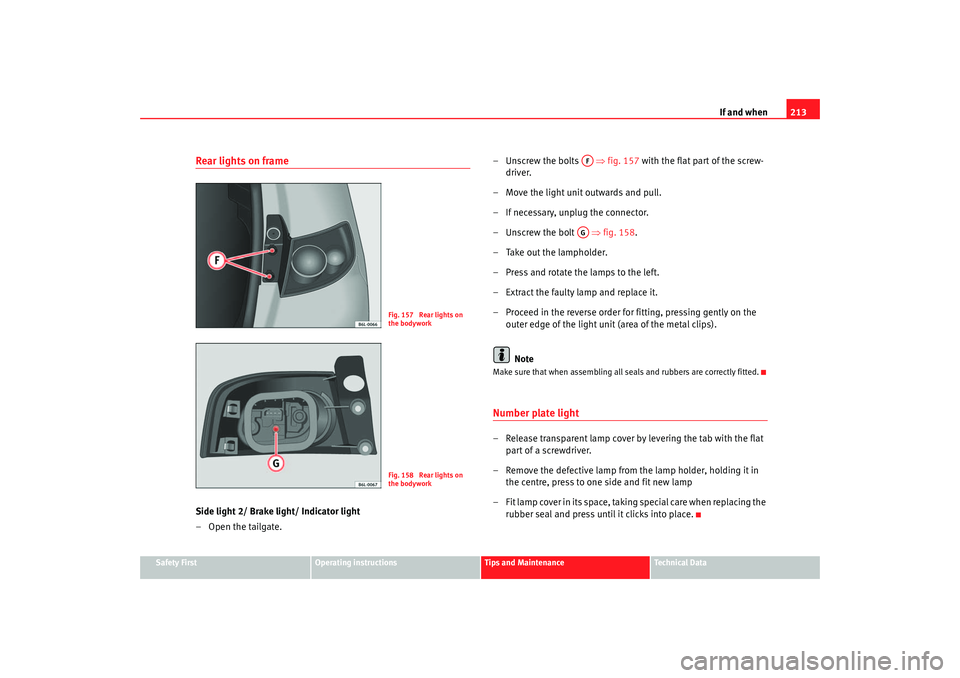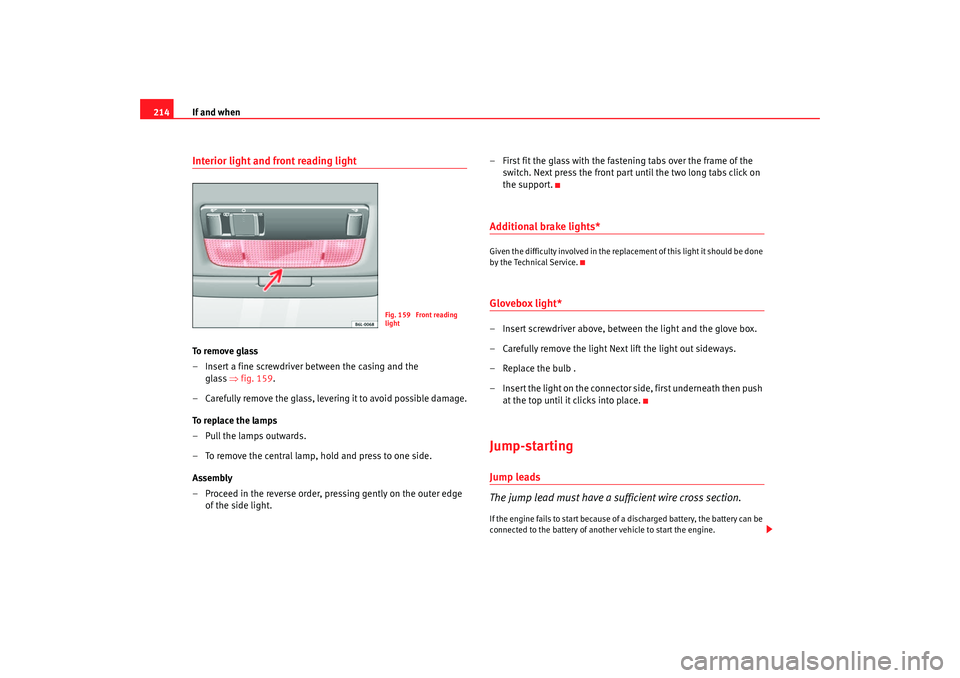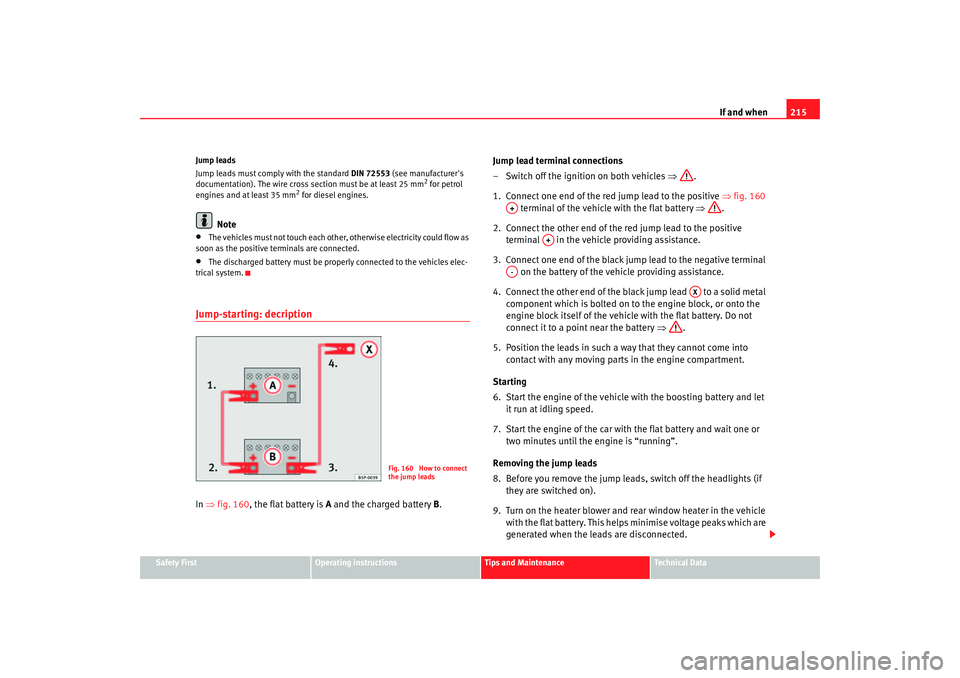Page 210 of 252
If and when
208Side beam lights– Raise the bonnet. – Remove the loops
⇒fig. 146 in the direction of the arrow and
remove the cover.
– Pull on the cables to release the lamp holder from the casing ⇒fig. 147.
–Pull on the lamp and replace.
– To assemble proceed in reverse order.
– Fit the plastic cover and secure the loop.
Fig. 146 Side lightsFig. 147 Side lights
A1
AC
ibiza_ingles Seite 208 Mittwoch, 5. Oktober 2005 5:17 17
Page 211 of 252
If and when209
Safety First
Operating instructions
Tips and Maintenance
Te c h n i c a l D a t a
Turn indicator lamps–Raise the bonnet. – Remove the loops
⇒fig. 148 in the direction of the arrow and
remove the cover.
– Turn the lamp holder to the left and remove from casing ⇒fig. 149 .
– Installation is done in the reverse order.
– Fit the plastic cover and secure the loop.
Fig. 148 Indicator lightsFig. 149 Indicator lights
A1
AD
ibiza_ingles Seite 209 Mittwoch, 5. Oktober 2005 5:17 17
Page 212 of 252
If and when
210Fog lights– Remove the grille, taking out the screw ⇒fig. 150, carefully
pull the grille on the side of the screw and release the cover. – Undo the two fastening screws
⇒fig. 150 and when released
unplug the connector.
– Turn the headlamp cover to the left a quarter turn.
– Unplug the lamp cable.
– Undo the lamp retainer spring and remove.
– Remove the lamp and fit the new lamp in the same position, making sure it sits correctly.
– Press the retaining spring on the lamp base and clip on.
– Plug in the lamp cable.
– The assembly of the cover and the headlamp is carried out in reverse order.
Fig. 150 Fog lightsFig. 151 Fog lights
AA
AF
ibiza_ingles Seite 210 Mittwoch, 5. Oktober 2005 5:17 17
Page 213 of 252
If and when211
Safety First
Operating instructions
Tips and Maintenance
Te c h n i c a l D a t a
Side indicator lamps– Press the indicator to the left or to the right to remove the lamp.
– Remove the lamp holder from the indicator.
– Remove the broken glass bulb and replace with a new bulb.
– Insert the lamp holder in the indicator guide until it clicks into
place.
– First fit the indicator in the opening in the chassis, fastening the tabs ⇒fig. 152 , and then fit in the lamp as shown by the
arrow ⇒fig. 152
Rear lights on the tailgate: Access to the light unitSide light 1/ Fog light/ reverse light
–Open the tailgate.
Fig. 152 Side indicators
A1A2
Fig. 153 Rear light on
tailgateFig. 154 Rear light on
tailgate
ibiza_ingles Seite 211 Mittwoch, 5. Oktober 2005 5:17 17
Page 214 of 252
If and when
212
– Remove the plastic cover ⇒page 211, fig. 153 and the
plastic caps ⇒page 211, fig. 153 carefully levering using a
screwdriver using the flat part of a screwdriver; avoid damage to
the paintwork.
– Extract the bolts ⇒page 211, fig. 154 and unplug the
connector.
– Remove the light from its housing.Rear lights on the tailgate: Access to the bulb
Side light 1/ Fog light/ reverse light
– Unscrew the bolts ⇒fig. 156 and remove the lampholder.
– Press and rotate the large lampholder to the left. In the case of a small lamp, rotate and extract the lampholder and pull on the
lamp.
– Remove lamp and replace.
– Fit the lampholder and proceed with installation.
– Fit the caps and the plastic cover ⇒ fig. 155.
NoteEnsure that all joints and rubber elements as well as the plastic caps are
correctly fitted during installation.
AA
AB
AC
Fig. 155 Rear light on
tailgate
Fig. 156 Access to the
lamp
AD
AB
AA
AB
ibiza_ingles Seite 212 Mittwoch, 5. Oktober 2005 5:17 17
Page 215 of 252

If and when213
Safety First
Operating instructions
Tips and Maintenance
Te c h n i c a l D a t a
Rear lights on frameSide light 2/ Brake light/ Indicator light
– Open the tailgate. –
Unscrew the bolts ⇒ fig. 157 wi th the flat part of the screw-
driver.
– Move the light unit outwards and pull.
– If necessary, unplug the connector.
– Unscrew the bolt ⇒fig. 158 .
– Take out the lampholder.
– Press and rotate the lamps to the left.
– Extract the faulty lamp and replace it.
– Proceed in the reverse order for fitting, pressing gently on the outer edge of the light unit (area of the metal clips).
Note
Make sure that when assembling all seals and rubbers are correctly fitted.Number plate light– Release transparent lamp cover by levering the tab with the flat part of a screwdriver.
– Remove the defective lamp from the lamp holder, holding it in the centre, press to one side and fit new lamp
– Fit lamp cover in its space, taking special care when replacing the rubber seal and press until it clicks into place.
Fig. 157 Rear lights on
the bodyworkFig. 158 Rear lights on
the bodywork
AFAG
ibiza_ingles Seite 213 Mittwoch, 5. Oktober 2005 5:17 17
Page 216 of 252

If and when
214Interior light and front reading light To r e m o v e g l a s s
– Insert a fine screwdriver between the casing and the
glass ⇒ fig. 159.
– Carefully remove the glass, levering it to avoid possible damage.
To replace the lamps
– Pull the lamps outwards.
– To remove the central lamp, hold and press to one side.
Assembly
– Proceed in the reverse order, pressing gently on the outer edge of the side light. – First fit the glass with the fastening tabs over the frame of the
switch. Next press the front part until the two long tabs click on
the support.
Additional brake lights*Given the difficulty involved in the replacement of this light it should be done
by the Technical Service.Glovebox light*– Insert screwdriver above, between the light and the glove box.
– Carefully remove the light Next lift the light out sideways.
– Replace the bulb .
– Insert the light on the connector side, first underneath then push at the top until it clicks into place.Jump-startingJump leads
The jump lead must have a sufficient wire cross section.If the engine fails to start because of a discharged battery, the battery can be
connected to the battery of anot her vehicle to start the engine.
Fig. 159 Front reading
light
ibiza_ingles Seite 214 Mittwoch, 5. Oktober 2005 5:17 17
Page 217 of 252

If and when215
Safety First
Operating instructions
Tips and Maintenance
Te c h n i c a l D a t a
Jump leads
Jump leads must comply with the standard
DIN 72553 (see manufacturer's
documentation). The wire cross section must be at least 25 mm
2 for petrol
engines and at least 35 mm
2 for diesel engines.
Note
•
The vehicles must not touch each other, otherwise electricity could flow as
soon as the positive terminals are connected.
•
The discharged battery must be properly connected to the vehicles elec-
trical system.
Jump-starting: decriptionIn ⇒ fig. 160, the flat battery is A and the charged battery B. Jump lead terminal connections
– Switch off the ignition on both vehicles
⇒.
1. Connect one end of the red jump lead to the positive ⇒fig. 160
terminal of the vehicle with the flat battery ⇒.
2. Connect the other end of the red jump lead to the positive terminal in the vehicle providing assistance.
3. Connect one end of the black jump lead to the negative terminal on the battery of the vehicle providing assistance.
4. Connect the other end of the black jump lead to a solid metal component which is bolted on to the engine block, or onto the
engine block itself of the vehicle with the flat battery. Do not
connect it to a point near the battery ⇒.
5. Position the leads in such a way that they cannot come into contact with any moving parts in the engine compartment.
Starting
6. Start the engine of the vehicle with the boosting battery and let
it run at idling speed.
7. Start the engine of the car with the flat battery and wait one or two minutes until the engine is “running”.
Removing the jump leads
8. Before you remove the jump leads, switch off the headlights (if they are switched on).
9. Turn on the heater blower and rear window heater in the vehicle with the flat battery. This helps minimise voltage peaks which are
generated when the leads are disconnected.
Fig. 160 How to connect
the jump leads
A+
A+
A-
AX
ibiza_ingles Seite 215 Mittwoch, 5. Oktober 2005 5:17 17